Leadership and Quality of Care in Healthcare Settings
VerifiedAdded on 2022/11/17
|8
|2902
|271
Essay
AI Summary
This essay delves into the crucial role of leadership within healthcare organizations, emphasizing its impact on the quality and integration of care. It defines leadership, highlighting the leader's responsibility in motivating individuals and teams to achieve organizational goals and objectives. The essay analyzes various leadership styles, with a focus on transformational leadership, and its influence on healthcare services at individual, team, and service levels. It incorporates personal observations from a nursing practice, illustrating the significance of leadership in fostering proper coordination, effective communication, and a positive work environment. The essay also addresses the importance of organizational culture, collaboration, and the leader's role in shaping ethical behaviors and ensuring quality care, ultimately contributing to improved patient outcomes. The paper also explores the six components of high-quality care: Safe, effective, reliable, patient-centered, efficient, and equitable.
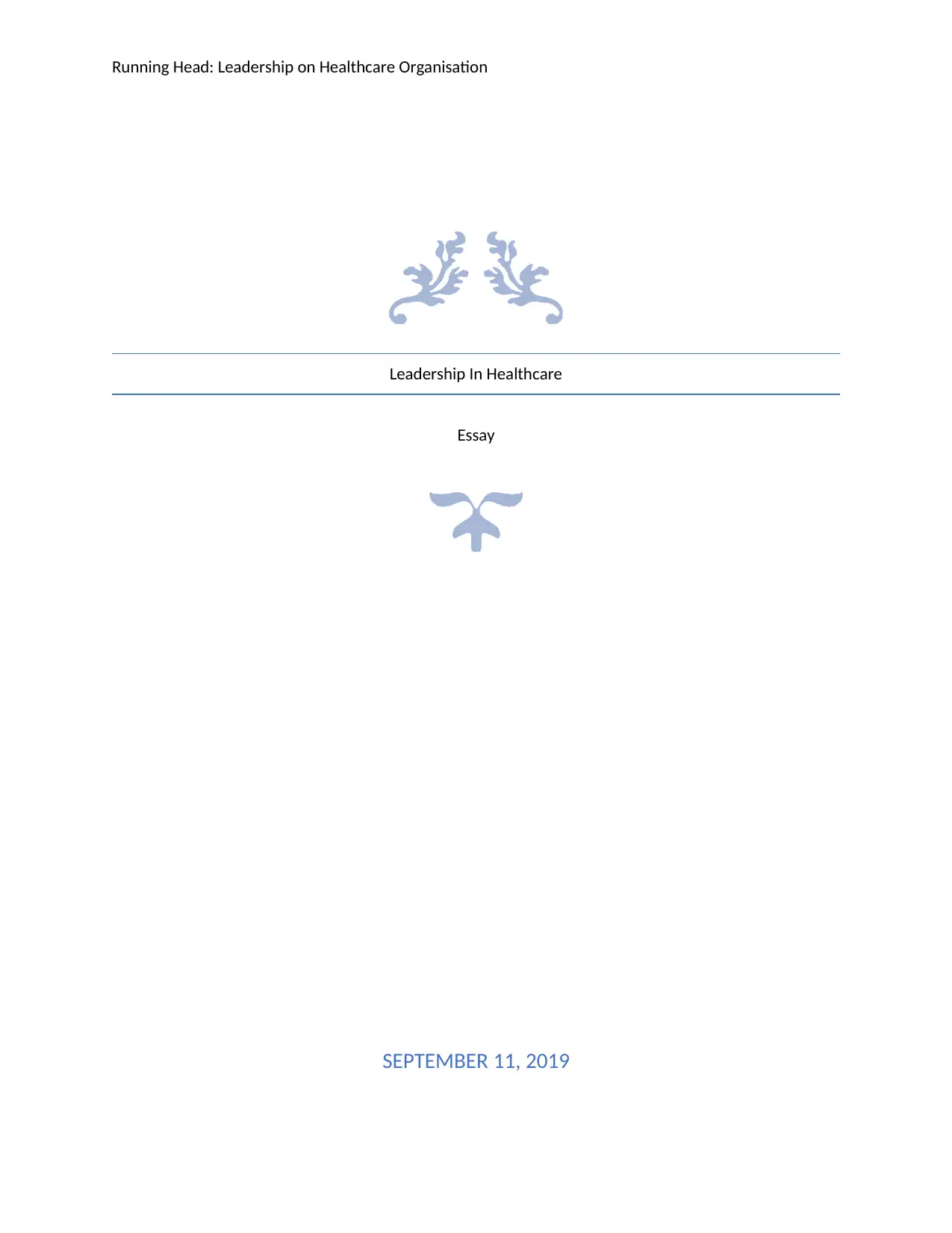
Running Head: Leadership on Healthcare Organisation
Leadership In Healthcare
Essay
SEPTEMBER 11, 2019
Leadership In Healthcare
Essay
SEPTEMBER 11, 2019
Paraphrase This Document
Need a fresh take? Get an instant paraphrase of this document with our AI Paraphraser
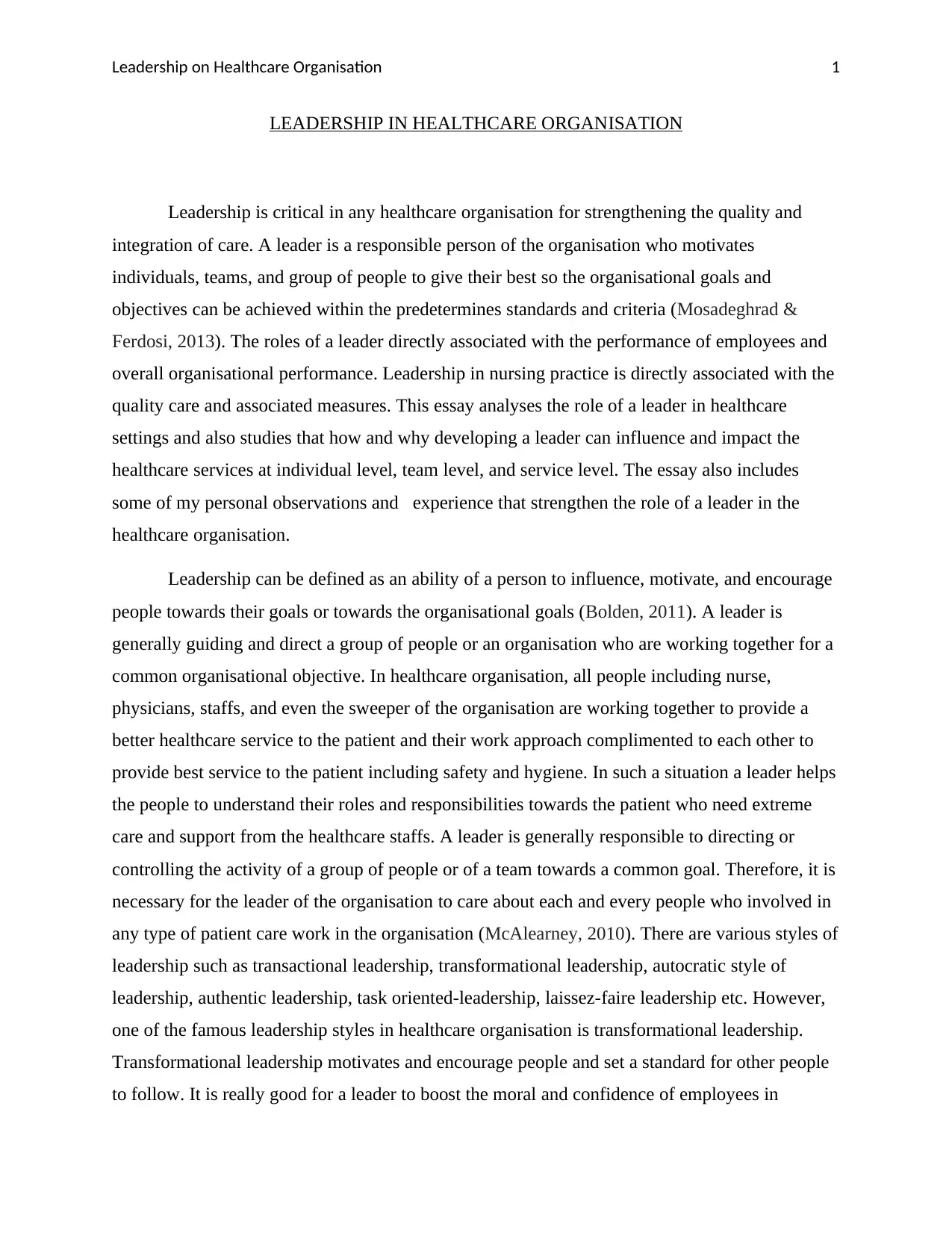
Leadership on Healthcare Organisation 1
LEADERSHIP IN HEALTHCARE ORGANISATION
Leadership is critical in any healthcare organisation for strengthening the quality and
integration of care. A leader is a responsible person of the organisation who motivates
individuals, teams, and group of people to give their best so the organisational goals and
objectives can be achieved within the predetermines standards and criteria (Mosadeghrad &
Ferdosi, 2013). The roles of a leader directly associated with the performance of employees and
overall organisational performance. Leadership in nursing practice is directly associated with the
quality care and associated measures. This essay analyses the role of a leader in healthcare
settings and also studies that how and why developing a leader can influence and impact the
healthcare services at individual level, team level, and service level. The essay also includes
some of my personal observations and experience that strengthen the role of a leader in the
healthcare organisation.
Leadership can be defined as an ability of a person to influence, motivate, and encourage
people towards their goals or towards the organisational goals (Bolden, 2011). A leader is
generally guiding and direct a group of people or an organisation who are working together for a
common organisational objective. In healthcare organisation, all people including nurse,
physicians, staffs, and even the sweeper of the organisation are working together to provide a
better healthcare service to the patient and their work approach complimented to each other to
provide best service to the patient including safety and hygiene. In such a situation a leader helps
the people to understand their roles and responsibilities towards the patient who need extreme
care and support from the healthcare staffs. A leader is generally responsible to directing or
controlling the activity of a group of people or of a team towards a common goal. Therefore, it is
necessary for the leader of the organisation to care about each and every people who involved in
any type of patient care work in the organisation (McAlearney, 2010). There are various styles of
leadership such as transactional leadership, transformational leadership, autocratic style of
leadership, authentic leadership, task oriented-leadership, laissez-faire leadership etc. However,
one of the famous leadership styles in healthcare organisation is transformational leadership.
Transformational leadership motivates and encourage people and set a standard for other people
to follow. It is really good for a leader to boost the moral and confidence of employees in
LEADERSHIP IN HEALTHCARE ORGANISATION
Leadership is critical in any healthcare organisation for strengthening the quality and
integration of care. A leader is a responsible person of the organisation who motivates
individuals, teams, and group of people to give their best so the organisational goals and
objectives can be achieved within the predetermines standards and criteria (Mosadeghrad &
Ferdosi, 2013). The roles of a leader directly associated with the performance of employees and
overall organisational performance. Leadership in nursing practice is directly associated with the
quality care and associated measures. This essay analyses the role of a leader in healthcare
settings and also studies that how and why developing a leader can influence and impact the
healthcare services at individual level, team level, and service level. The essay also includes
some of my personal observations and experience that strengthen the role of a leader in the
healthcare organisation.
Leadership can be defined as an ability of a person to influence, motivate, and encourage
people towards their goals or towards the organisational goals (Bolden, 2011). A leader is
generally guiding and direct a group of people or an organisation who are working together for a
common organisational objective. In healthcare organisation, all people including nurse,
physicians, staffs, and even the sweeper of the organisation are working together to provide a
better healthcare service to the patient and their work approach complimented to each other to
provide best service to the patient including safety and hygiene. In such a situation a leader helps
the people to understand their roles and responsibilities towards the patient who need extreme
care and support from the healthcare staffs. A leader is generally responsible to directing or
controlling the activity of a group of people or of a team towards a common goal. Therefore, it is
necessary for the leader of the organisation to care about each and every people who involved in
any type of patient care work in the organisation (McAlearney, 2010). There are various styles of
leadership such as transactional leadership, transformational leadership, autocratic style of
leadership, authentic leadership, task oriented-leadership, laissez-faire leadership etc. However,
one of the famous leadership styles in healthcare organisation is transformational leadership.
Transformational leadership motivates and encourage people and set a standard for other people
to follow. It is really good for a leader to boost the moral and confidence of employees in
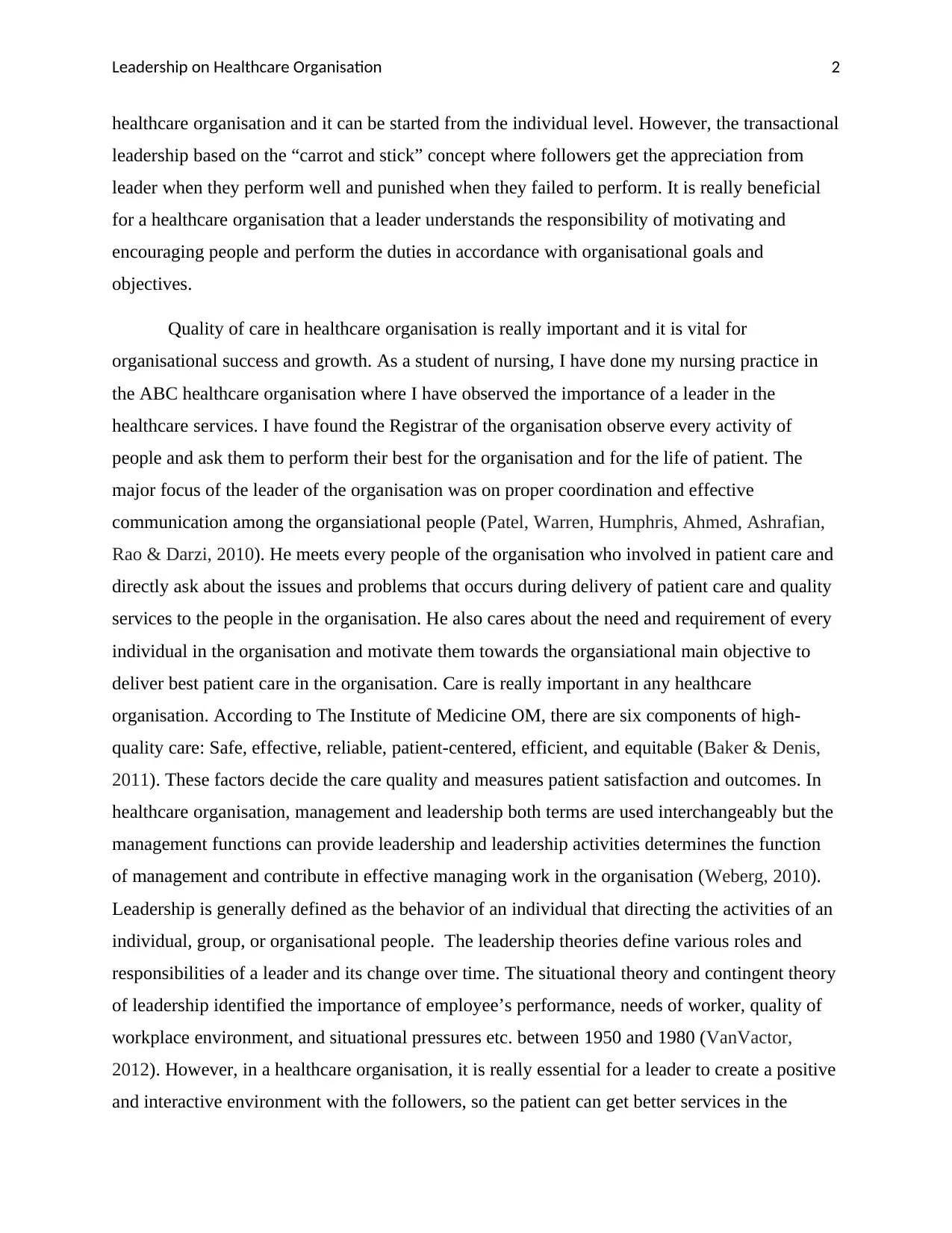
Leadership on Healthcare Organisation 2
healthcare organisation and it can be started from the individual level. However, the transactional
leadership based on the “carrot and stick” concept where followers get the appreciation from
leader when they perform well and punished when they failed to perform. It is really beneficial
for a healthcare organisation that a leader understands the responsibility of motivating and
encouraging people and perform the duties in accordance with organisational goals and
objectives.
Quality of care in healthcare organisation is really important and it is vital for
organisational success and growth. As a student of nursing, I have done my nursing practice in
the ABC healthcare organisation where I have observed the importance of a leader in the
healthcare services. I have found the Registrar of the organisation observe every activity of
people and ask them to perform their best for the organisation and for the life of patient. The
major focus of the leader of the organisation was on proper coordination and effective
communication among the organsiational people (Patel, Warren, Humphris, Ahmed, Ashrafian,
Rao & Darzi, 2010). He meets every people of the organisation who involved in patient care and
directly ask about the issues and problems that occurs during delivery of patient care and quality
services to the people in the organisation. He also cares about the need and requirement of every
individual in the organisation and motivate them towards the organsiational main objective to
deliver best patient care in the organisation. Care is really important in any healthcare
organisation. According to The Institute of Medicine OM, there are six components of high-
quality care: Safe, effective, reliable, patient-centered, efficient, and equitable (Baker & Denis,
2011). These factors decide the care quality and measures patient satisfaction and outcomes. In
healthcare organisation, management and leadership both terms are used interchangeably but the
management functions can provide leadership and leadership activities determines the function
of management and contribute in effective managing work in the organisation (Weberg, 2010).
Leadership is generally defined as the behavior of an individual that directing the activities of an
individual, group, or organisational people. The leadership theories define various roles and
responsibilities of a leader and its change over time. The situational theory and contingent theory
of leadership identified the importance of employee’s performance, needs of worker, quality of
workplace environment, and situational pressures etc. between 1950 and 1980 (VanVactor,
2012). However, in a healthcare organisation, it is really essential for a leader to create a positive
and interactive environment with the followers, so the patient can get better services in the
healthcare organisation and it can be started from the individual level. However, the transactional
leadership based on the “carrot and stick” concept where followers get the appreciation from
leader when they perform well and punished when they failed to perform. It is really beneficial
for a healthcare organisation that a leader understands the responsibility of motivating and
encouraging people and perform the duties in accordance with organisational goals and
objectives.
Quality of care in healthcare organisation is really important and it is vital for
organisational success and growth. As a student of nursing, I have done my nursing practice in
the ABC healthcare organisation where I have observed the importance of a leader in the
healthcare services. I have found the Registrar of the organisation observe every activity of
people and ask them to perform their best for the organisation and for the life of patient. The
major focus of the leader of the organisation was on proper coordination and effective
communication among the organsiational people (Patel, Warren, Humphris, Ahmed, Ashrafian,
Rao & Darzi, 2010). He meets every people of the organisation who involved in patient care and
directly ask about the issues and problems that occurs during delivery of patient care and quality
services to the people in the organisation. He also cares about the need and requirement of every
individual in the organisation and motivate them towards the organsiational main objective to
deliver best patient care in the organisation. Care is really important in any healthcare
organisation. According to The Institute of Medicine OM, there are six components of high-
quality care: Safe, effective, reliable, patient-centered, efficient, and equitable (Baker & Denis,
2011). These factors decide the care quality and measures patient satisfaction and outcomes. In
healthcare organisation, management and leadership both terms are used interchangeably but the
management functions can provide leadership and leadership activities determines the function
of management and contribute in effective managing work in the organisation (Weberg, 2010).
Leadership is generally defined as the behavior of an individual that directing the activities of an
individual, group, or organisational people. The leadership theories define various roles and
responsibilities of a leader and its change over time. The situational theory and contingent theory
of leadership identified the importance of employee’s performance, needs of worker, quality of
workplace environment, and situational pressures etc. between 1950 and 1980 (VanVactor,
2012). However, in a healthcare organisation, it is really essential for a leader to create a positive
and interactive environment with the followers, so the patient can get better services in the
⊘ This is a preview!⊘
Do you want full access?
Subscribe today to unlock all pages.

Trusted by 1+ million students worldwide
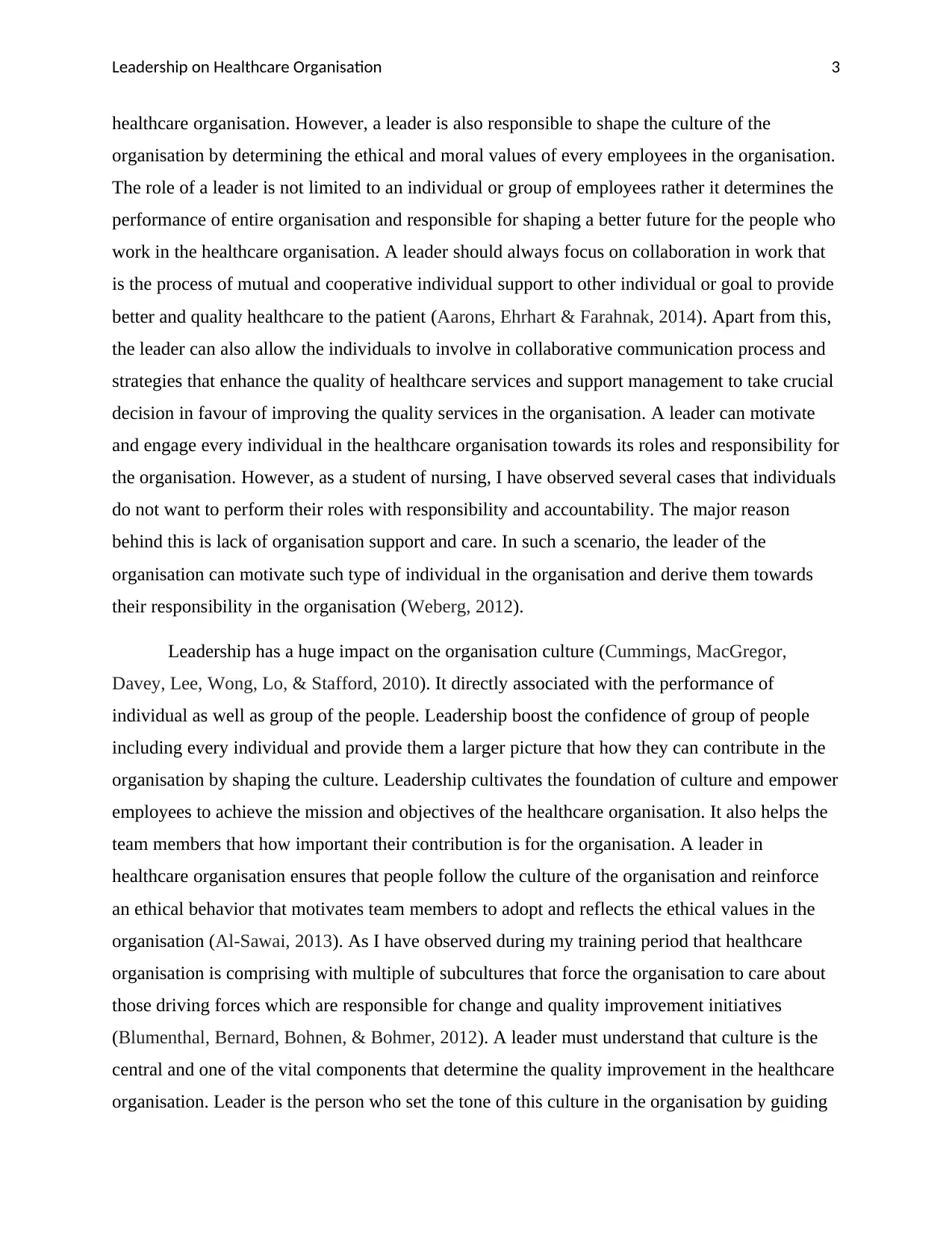
Leadership on Healthcare Organisation 3
healthcare organisation. However, a leader is also responsible to shape the culture of the
organisation by determining the ethical and moral values of every employees in the organisation.
The role of a leader is not limited to an individual or group of employees rather it determines the
performance of entire organisation and responsible for shaping a better future for the people who
work in the healthcare organisation. A leader should always focus on collaboration in work that
is the process of mutual and cooperative individual support to other individual or goal to provide
better and quality healthcare to the patient (Aarons, Ehrhart & Farahnak, 2014). Apart from this,
the leader can also allow the individuals to involve in collaborative communication process and
strategies that enhance the quality of healthcare services and support management to take crucial
decision in favour of improving the quality services in the organisation. A leader can motivate
and engage every individual in the healthcare organisation towards its roles and responsibility for
the organisation. However, as a student of nursing, I have observed several cases that individuals
do not want to perform their roles with responsibility and accountability. The major reason
behind this is lack of organisation support and care. In such a scenario, the leader of the
organisation can motivate such type of individual in the organisation and derive them towards
their responsibility in the organisation (Weberg, 2012).
Leadership has a huge impact on the organisation culture (Cummings, MacGregor,
Davey, Lee, Wong, Lo, & Stafford, 2010). It directly associated with the performance of
individual as well as group of the people. Leadership boost the confidence of group of people
including every individual and provide them a larger picture that how they can contribute in the
organisation by shaping the culture. Leadership cultivates the foundation of culture and empower
employees to achieve the mission and objectives of the healthcare organisation. It also helps the
team members that how important their contribution is for the organisation. A leader in
healthcare organisation ensures that people follow the culture of the organisation and reinforce
an ethical behavior that motivates team members to adopt and reflects the ethical values in the
organisation (Al-Sawai, 2013). As I have observed during my training period that healthcare
organisation is comprising with multiple of subcultures that force the organisation to care about
those driving forces which are responsible for change and quality improvement initiatives
(Blumenthal, Bernard, Bohnen, & Bohmer, 2012). A leader must understand that culture is the
central and one of the vital components that determine the quality improvement in the healthcare
organisation. Leader is the person who set the tone of this culture in the organisation by guiding
healthcare organisation. However, a leader is also responsible to shape the culture of the
organisation by determining the ethical and moral values of every employees in the organisation.
The role of a leader is not limited to an individual or group of employees rather it determines the
performance of entire organisation and responsible for shaping a better future for the people who
work in the healthcare organisation. A leader should always focus on collaboration in work that
is the process of mutual and cooperative individual support to other individual or goal to provide
better and quality healthcare to the patient (Aarons, Ehrhart & Farahnak, 2014). Apart from this,
the leader can also allow the individuals to involve in collaborative communication process and
strategies that enhance the quality of healthcare services and support management to take crucial
decision in favour of improving the quality services in the organisation. A leader can motivate
and engage every individual in the healthcare organisation towards its roles and responsibility for
the organisation. However, as a student of nursing, I have observed several cases that individuals
do not want to perform their roles with responsibility and accountability. The major reason
behind this is lack of organisation support and care. In such a scenario, the leader of the
organisation can motivate such type of individual in the organisation and derive them towards
their responsibility in the organisation (Weberg, 2012).
Leadership has a huge impact on the organisation culture (Cummings, MacGregor,
Davey, Lee, Wong, Lo, & Stafford, 2010). It directly associated with the performance of
individual as well as group of the people. Leadership boost the confidence of group of people
including every individual and provide them a larger picture that how they can contribute in the
organisation by shaping the culture. Leadership cultivates the foundation of culture and empower
employees to achieve the mission and objectives of the healthcare organisation. It also helps the
team members that how important their contribution is for the organisation. A leader in
healthcare organisation ensures that people follow the culture of the organisation and reinforce
an ethical behavior that motivates team members to adopt and reflects the ethical values in the
organisation (Al-Sawai, 2013). As I have observed during my training period that healthcare
organisation is comprising with multiple of subcultures that force the organisation to care about
those driving forces which are responsible for change and quality improvement initiatives
(Blumenthal, Bernard, Bohnen, & Bohmer, 2012). A leader must understand that culture is the
central and one of the vital components that determine the quality improvement in the healthcare
organisation. Leader is the person who set the tone of this culture in the organisation by guiding
Paraphrase This Document
Need a fresh take? Get an instant paraphrase of this document with our AI Paraphraser
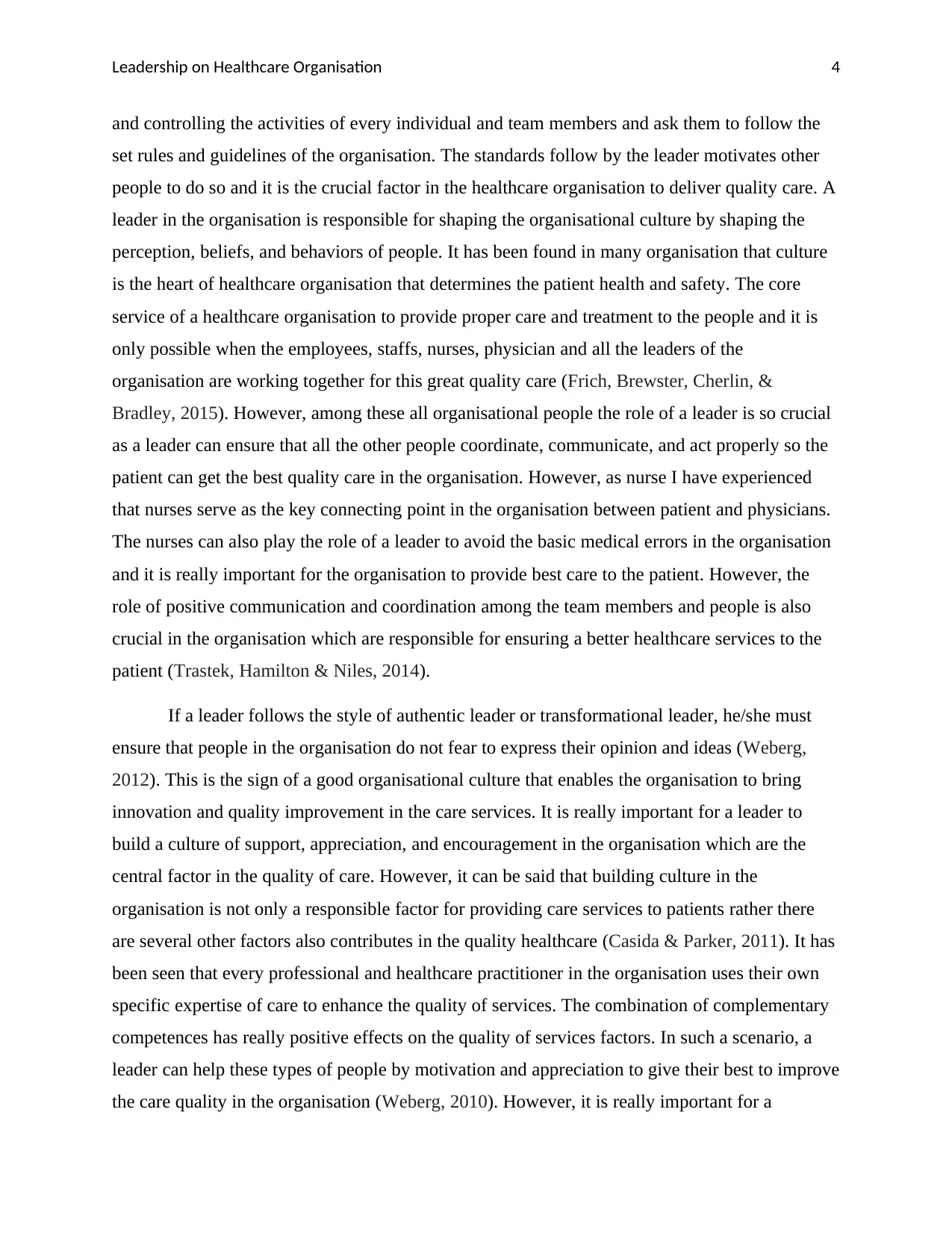
Leadership on Healthcare Organisation 4
and controlling the activities of every individual and team members and ask them to follow the
set rules and guidelines of the organisation. The standards follow by the leader motivates other
people to do so and it is the crucial factor in the healthcare organisation to deliver quality care. A
leader in the organisation is responsible for shaping the organisational culture by shaping the
perception, beliefs, and behaviors of people. It has been found in many organisation that culture
is the heart of healthcare organisation that determines the patient health and safety. The core
service of a healthcare organisation to provide proper care and treatment to the people and it is
only possible when the employees, staffs, nurses, physician and all the leaders of the
organisation are working together for this great quality care (Frich, Brewster, Cherlin, &
Bradley, 2015). However, among these all organisational people the role of a leader is so crucial
as a leader can ensure that all the other people coordinate, communicate, and act properly so the
patient can get the best quality care in the organisation. However, as nurse I have experienced
that nurses serve as the key connecting point in the organisation between patient and physicians.
The nurses can also play the role of a leader to avoid the basic medical errors in the organisation
and it is really important for the organisation to provide best care to the patient. However, the
role of positive communication and coordination among the team members and people is also
crucial in the organisation which are responsible for ensuring a better healthcare services to the
patient (Trastek, Hamilton & Niles, 2014).
If a leader follows the style of authentic leader or transformational leader, he/she must
ensure that people in the organisation do not fear to express their opinion and ideas (Weberg,
2012). This is the sign of a good organisational culture that enables the organisation to bring
innovation and quality improvement in the care services. It is really important for a leader to
build a culture of support, appreciation, and encouragement in the organisation which are the
central factor in the quality of care. However, it can be said that building culture in the
organisation is not only a responsible factor for providing care services to patients rather there
are several other factors also contributes in the quality healthcare (Casida & Parker, 2011). It has
been seen that every professional and healthcare practitioner in the organisation uses their own
specific expertise of care to enhance the quality of services. The combination of complementary
competences has really positive effects on the quality of services factors. In such a scenario, a
leader can help these types of people by motivation and appreciation to give their best to improve
the care quality in the organisation (Weberg, 2010). However, it is really important for a
and controlling the activities of every individual and team members and ask them to follow the
set rules and guidelines of the organisation. The standards follow by the leader motivates other
people to do so and it is the crucial factor in the healthcare organisation to deliver quality care. A
leader in the organisation is responsible for shaping the organisational culture by shaping the
perception, beliefs, and behaviors of people. It has been found in many organisation that culture
is the heart of healthcare organisation that determines the patient health and safety. The core
service of a healthcare organisation to provide proper care and treatment to the people and it is
only possible when the employees, staffs, nurses, physician and all the leaders of the
organisation are working together for this great quality care (Frich, Brewster, Cherlin, &
Bradley, 2015). However, among these all organisational people the role of a leader is so crucial
as a leader can ensure that all the other people coordinate, communicate, and act properly so the
patient can get the best quality care in the organisation. However, as nurse I have experienced
that nurses serve as the key connecting point in the organisation between patient and physicians.
The nurses can also play the role of a leader to avoid the basic medical errors in the organisation
and it is really important for the organisation to provide best care to the patient. However, the
role of positive communication and coordination among the team members and people is also
crucial in the organisation which are responsible for ensuring a better healthcare services to the
patient (Trastek, Hamilton & Niles, 2014).
If a leader follows the style of authentic leader or transformational leader, he/she must
ensure that people in the organisation do not fear to express their opinion and ideas (Weberg,
2012). This is the sign of a good organisational culture that enables the organisation to bring
innovation and quality improvement in the care services. It is really important for a leader to
build a culture of support, appreciation, and encouragement in the organisation which are the
central factor in the quality of care. However, it can be said that building culture in the
organisation is not only a responsible factor for providing care services to patients rather there
are several other factors also contributes in the quality healthcare (Casida & Parker, 2011). It has
been seen that every professional and healthcare practitioner in the organisation uses their own
specific expertise of care to enhance the quality of services. The combination of complementary
competences has really positive effects on the quality of services factors. In such a scenario, a
leader can help these types of people by motivation and appreciation to give their best to improve
the care quality in the organisation (Weberg, 2010). However, it is really important for a
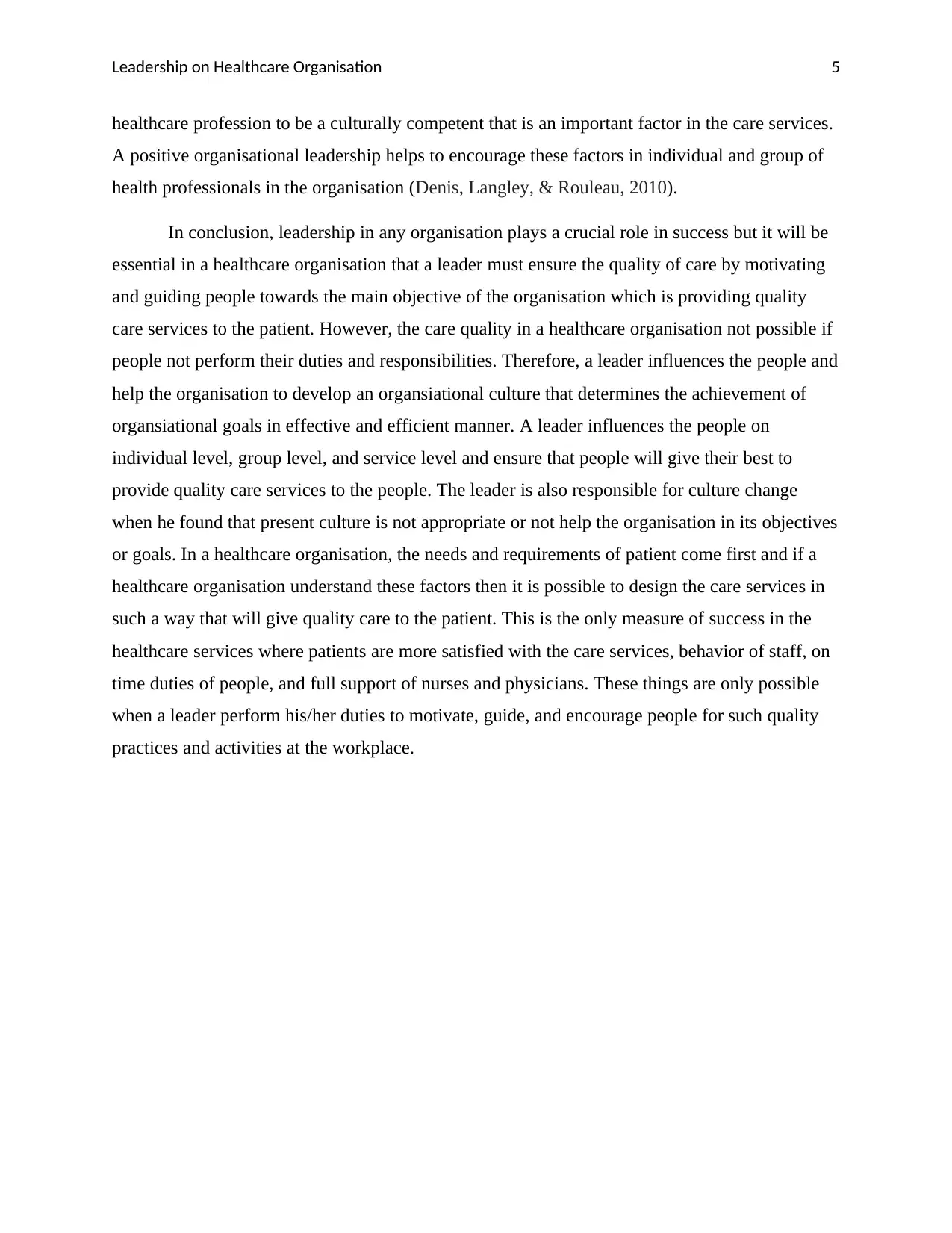
Leadership on Healthcare Organisation 5
healthcare profession to be a culturally competent that is an important factor in the care services.
A positive organisational leadership helps to encourage these factors in individual and group of
health professionals in the organisation (Denis, Langley, & Rouleau, 2010).
In conclusion, leadership in any organisation plays a crucial role in success but it will be
essential in a healthcare organisation that a leader must ensure the quality of care by motivating
and guiding people towards the main objective of the organisation which is providing quality
care services to the patient. However, the care quality in a healthcare organisation not possible if
people not perform their duties and responsibilities. Therefore, a leader influences the people and
help the organisation to develop an organsiational culture that determines the achievement of
organsiational goals in effective and efficient manner. A leader influences the people on
individual level, group level, and service level and ensure that people will give their best to
provide quality care services to the people. The leader is also responsible for culture change
when he found that present culture is not appropriate or not help the organisation in its objectives
or goals. In a healthcare organisation, the needs and requirements of patient come first and if a
healthcare organisation understand these factors then it is possible to design the care services in
such a way that will give quality care to the patient. This is the only measure of success in the
healthcare services where patients are more satisfied with the care services, behavior of staff, on
time duties of people, and full support of nurses and physicians. These things are only possible
when a leader perform his/her duties to motivate, guide, and encourage people for such quality
practices and activities at the workplace.
healthcare profession to be a culturally competent that is an important factor in the care services.
A positive organisational leadership helps to encourage these factors in individual and group of
health professionals in the organisation (Denis, Langley, & Rouleau, 2010).
In conclusion, leadership in any organisation plays a crucial role in success but it will be
essential in a healthcare organisation that a leader must ensure the quality of care by motivating
and guiding people towards the main objective of the organisation which is providing quality
care services to the patient. However, the care quality in a healthcare organisation not possible if
people not perform their duties and responsibilities. Therefore, a leader influences the people and
help the organisation to develop an organsiational culture that determines the achievement of
organsiational goals in effective and efficient manner. A leader influences the people on
individual level, group level, and service level and ensure that people will give their best to
provide quality care services to the people. The leader is also responsible for culture change
when he found that present culture is not appropriate or not help the organisation in its objectives
or goals. In a healthcare organisation, the needs and requirements of patient come first and if a
healthcare organisation understand these factors then it is possible to design the care services in
such a way that will give quality care to the patient. This is the only measure of success in the
healthcare services where patients are more satisfied with the care services, behavior of staff, on
time duties of people, and full support of nurses and physicians. These things are only possible
when a leader perform his/her duties to motivate, guide, and encourage people for such quality
practices and activities at the workplace.
⊘ This is a preview!⊘
Do you want full access?
Subscribe today to unlock all pages.

Trusted by 1+ million students worldwide
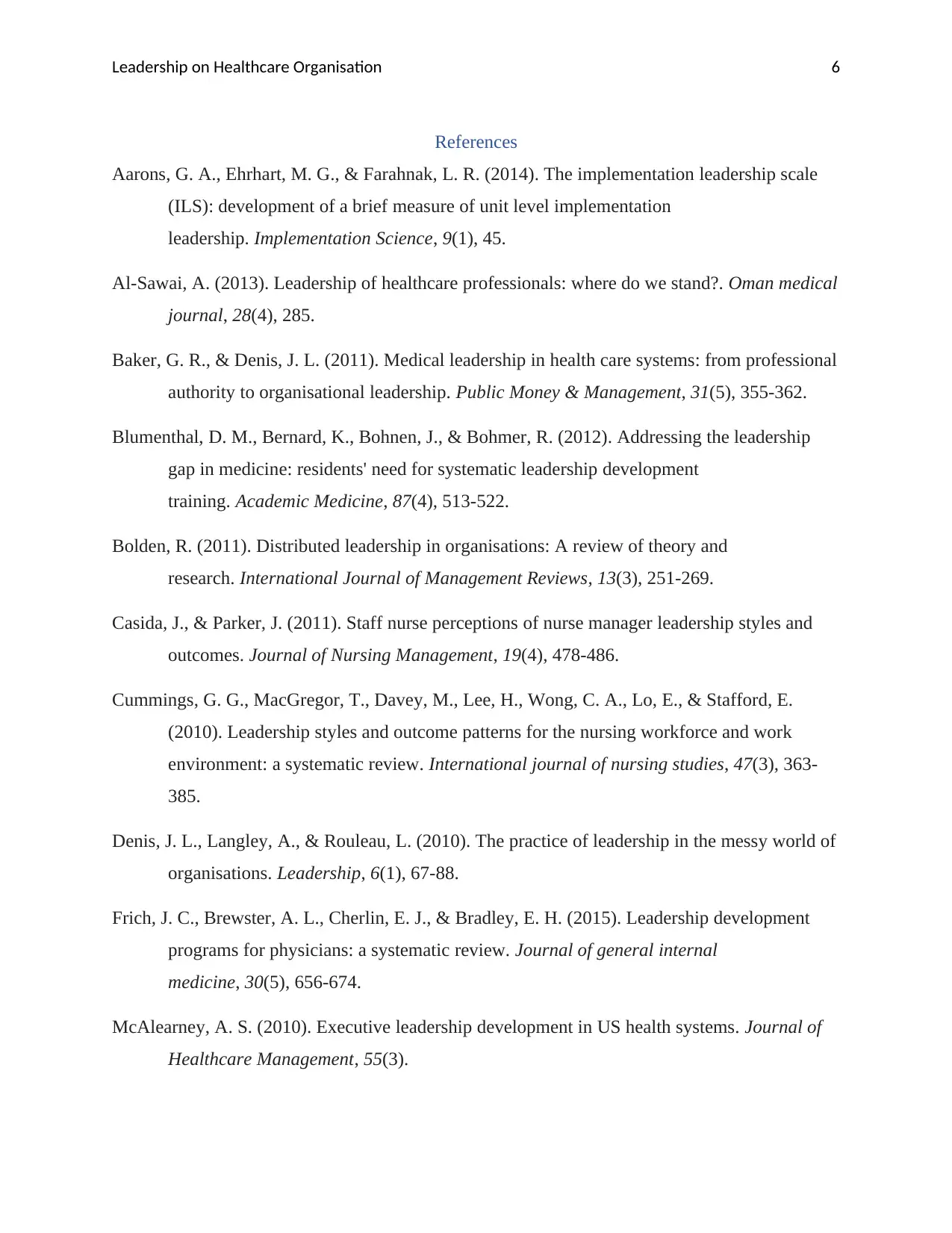
Leadership on Healthcare Organisation 6
References
Aarons, G. A., Ehrhart, M. G., & Farahnak, L. R. (2014). The implementation leadership scale
(ILS): development of a brief measure of unit level implementation
leadership. Implementation Science, 9(1), 45.
Al-Sawai, A. (2013). Leadership of healthcare professionals: where do we stand?. Oman medical
journal, 28(4), 285.
Baker, G. R., & Denis, J. L. (2011). Medical leadership in health care systems: from professional
authority to organisational leadership. Public Money & Management, 31(5), 355-362.
Blumenthal, D. M., Bernard, K., Bohnen, J., & Bohmer, R. (2012). Addressing the leadership
gap in medicine: residents' need for systematic leadership development
training. Academic Medicine, 87(4), 513-522.
Bolden, R. (2011). Distributed leadership in organisations: A review of theory and
research. International Journal of Management Reviews, 13(3), 251-269.
Casida, J., & Parker, J. (2011). Staff nurse perceptions of nurse manager leadership styles and
outcomes. Journal of Nursing Management, 19(4), 478-486.
Cummings, G. G., MacGregor, T., Davey, M., Lee, H., Wong, C. A., Lo, E., & Stafford, E.
(2010). Leadership styles and outcome patterns for the nursing workforce and work
environment: a systematic review. International journal of nursing studies, 47(3), 363-
385.
Denis, J. L., Langley, A., & Rouleau, L. (2010). The practice of leadership in the messy world of
organisations. Leadership, 6(1), 67-88.
Frich, J. C., Brewster, A. L., Cherlin, E. J., & Bradley, E. H. (2015). Leadership development
programs for physicians: a systematic review. Journal of general internal
medicine, 30(5), 656-674.
McAlearney, A. S. (2010). Executive leadership development in US health systems. Journal of
Healthcare Management, 55(3).
References
Aarons, G. A., Ehrhart, M. G., & Farahnak, L. R. (2014). The implementation leadership scale
(ILS): development of a brief measure of unit level implementation
leadership. Implementation Science, 9(1), 45.
Al-Sawai, A. (2013). Leadership of healthcare professionals: where do we stand?. Oman medical
journal, 28(4), 285.
Baker, G. R., & Denis, J. L. (2011). Medical leadership in health care systems: from professional
authority to organisational leadership. Public Money & Management, 31(5), 355-362.
Blumenthal, D. M., Bernard, K., Bohnen, J., & Bohmer, R. (2012). Addressing the leadership
gap in medicine: residents' need for systematic leadership development
training. Academic Medicine, 87(4), 513-522.
Bolden, R. (2011). Distributed leadership in organisations: A review of theory and
research. International Journal of Management Reviews, 13(3), 251-269.
Casida, J., & Parker, J. (2011). Staff nurse perceptions of nurse manager leadership styles and
outcomes. Journal of Nursing Management, 19(4), 478-486.
Cummings, G. G., MacGregor, T., Davey, M., Lee, H., Wong, C. A., Lo, E., & Stafford, E.
(2010). Leadership styles and outcome patterns for the nursing workforce and work
environment: a systematic review. International journal of nursing studies, 47(3), 363-
385.
Denis, J. L., Langley, A., & Rouleau, L. (2010). The practice of leadership in the messy world of
organisations. Leadership, 6(1), 67-88.
Frich, J. C., Brewster, A. L., Cherlin, E. J., & Bradley, E. H. (2015). Leadership development
programs for physicians: a systematic review. Journal of general internal
medicine, 30(5), 656-674.
McAlearney, A. S. (2010). Executive leadership development in US health systems. Journal of
Healthcare Management, 55(3).
Paraphrase This Document
Need a fresh take? Get an instant paraphrase of this document with our AI Paraphraser
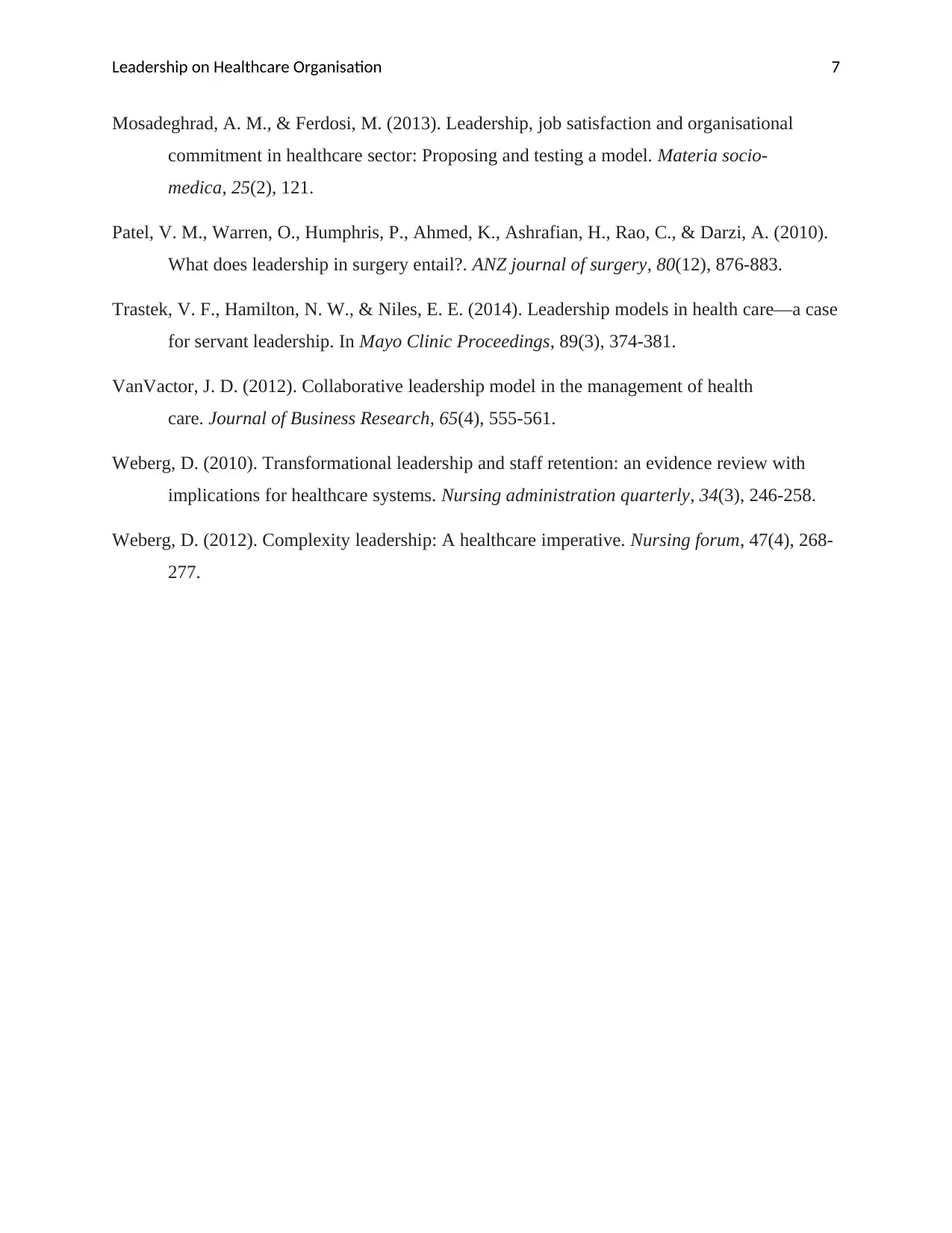
Leadership on Healthcare Organisation 7
Mosadeghrad, A. M., & Ferdosi, M. (2013). Leadership, job satisfaction and organisational
commitment in healthcare sector: Proposing and testing a model. Materia socio-
medica, 25(2), 121.
Patel, V. M., Warren, O., Humphris, P., Ahmed, K., Ashrafian, H., Rao, C., & Darzi, A. (2010).
What does leadership in surgery entail?. ANZ journal of surgery, 80(12), 876-883.
Trastek, V. F., Hamilton, N. W., & Niles, E. E. (2014). Leadership models in health care—a case
for servant leadership. In Mayo Clinic Proceedings, 89(3), 374-381.
VanVactor, J. D. (2012). Collaborative leadership model in the management of health
care. Journal of Business Research, 65(4), 555-561.
Weberg, D. (2010). Transformational leadership and staff retention: an evidence review with
implications for healthcare systems. Nursing administration quarterly, 34(3), 246-258.
Weberg, D. (2012). Complexity leadership: A healthcare imperative. Nursing forum, 47(4), 268-
277.
Mosadeghrad, A. M., & Ferdosi, M. (2013). Leadership, job satisfaction and organisational
commitment in healthcare sector: Proposing and testing a model. Materia socio-
medica, 25(2), 121.
Patel, V. M., Warren, O., Humphris, P., Ahmed, K., Ashrafian, H., Rao, C., & Darzi, A. (2010).
What does leadership in surgery entail?. ANZ journal of surgery, 80(12), 876-883.
Trastek, V. F., Hamilton, N. W., & Niles, E. E. (2014). Leadership models in health care—a case
for servant leadership. In Mayo Clinic Proceedings, 89(3), 374-381.
VanVactor, J. D. (2012). Collaborative leadership model in the management of health
care. Journal of Business Research, 65(4), 555-561.
Weberg, D. (2010). Transformational leadership and staff retention: an evidence review with
implications for healthcare systems. Nursing administration quarterly, 34(3), 246-258.
Weberg, D. (2012). Complexity leadership: A healthcare imperative. Nursing forum, 47(4), 268-
277.
1 out of 8
Related Documents
Your All-in-One AI-Powered Toolkit for Academic Success.
+13062052269
info@desklib.com
Available 24*7 on WhatsApp / Email
![[object Object]](/_next/static/media/star-bottom.7253800d.svg)
Unlock your academic potential
Copyright © 2020–2025 A2Z Services. All Rights Reserved. Developed and managed by ZUCOL.




